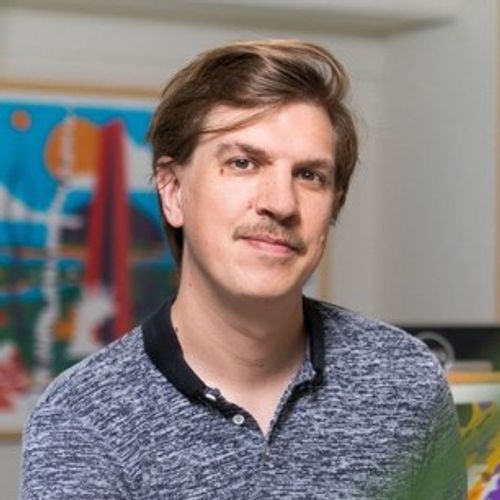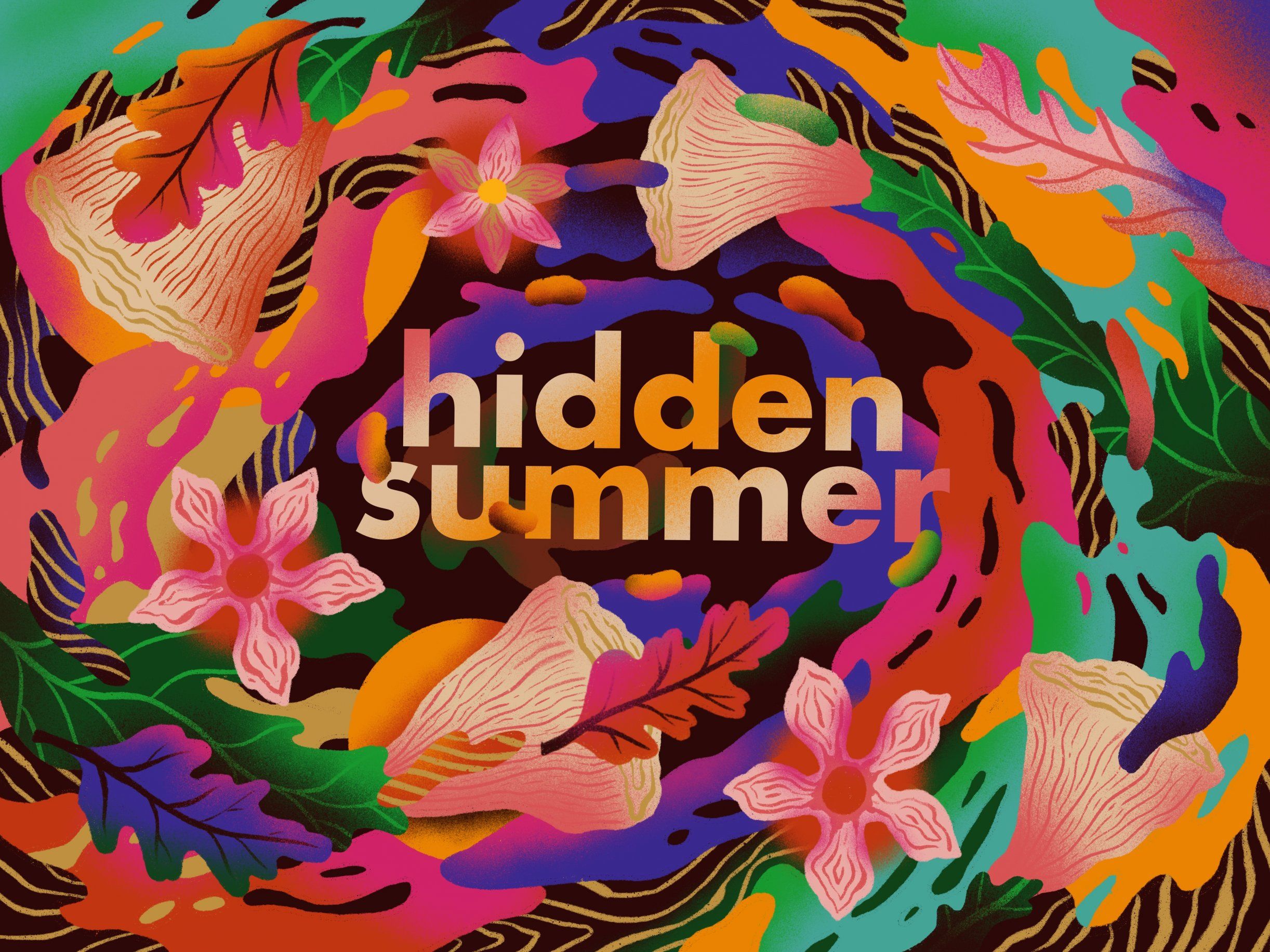
You can lose yourself in the vibrant colors, dynamic patterns and otherworldly forms of Nick Liefhebber’s collage-influenced illustrations. Splitting his time between commissions, branding, and his own prints, he builds bold kinetic worlds from simple shapes and intricate textures, revelling in a fearless use of color.
‘Fearless’ describes every aspect of Nick’s art, including his willingness to experiment with tools and techniques. He dove into completing a piece with Procreate for the first time to bring us the joyful image below.

Nick spoke with us about combining real-media methods with digital tools, developing an iconic style, and finding your own path to a career in illustration.
You recently did a commission for us to celebrate the release of Procreate 4.3. This was your first time using Procreate professionally for more than just sketching - how did you find it?
Yes, my workflow is usually different. Most of my illustrations are made like a collage from paper and digitally cut shapes. I mostly use drawing as a tool to set up the basic composition. Procreate made me love drawing again and the workflow was so fluid. It’s really in the sweet spot between good simplicity and enough sophistication in features.
What’s your favorite tool in Procreate?
The ability to tweak the brushes, streamline them, add a bit of jitter, and change the taper so easily - again, just enough possibilities. It’s also got a great user interface, and I like the fact I can use professional drawing software on the couch.
What’s the one tool you wish Procreate had?
I use a lot of patterns in my work; pattern fills or just overall patterns. It’d be great to draw those directly in Procreate. Additionally, it might be cool to use those patterns as fills in shapes, but I’m not sure if that’s a good idea, since it might remove the draw-and-paint feel which is such a plus. It might become too technical.
Did you go to art school?
I went to Utrecht University of the Arts and studied graphic design. I wasn’t admitted to the illustration course, which I understand, since I didn’t really know what I was doing. I loved illustration though, and started creating images on the side, in my own way - collages with my own created elements and rules. After that I started to draw in that style and now it’s evolving into something new again. I just took my own different path. Now illustration has taken over a big part of my professional work.

What’s your creative process like, from coming up with the inspiration for concepts through to finished pieces?
I build my images like a collage. Usually I start by thinking of iconic elements representing the theme of the illustration, which I then draw or cut from paper to create a collection of icons. Then I start sketching to find a basic composition. I like movement and dynamic shapes, so that’s important to me. I prefer dynamism over refinement, which can become a bit more static in my work.
Then I start creating the image, sometimes drawing, sometimes making the digital collage. Usually I end up with an image that is different to my sketches along the way. My inspiration for my own work comes from everywhere, but I want my work to be a connected world telling abstract stories. Some elements keep returning, building a visual language.
Your artwork is incredibly distinctive. How did you find your iconic style and how long did it take you to find something you were comfortable with? Do have you any advice for artists or aspiring artists who are still trying to find their style?
I covered some of this in the previous questions, but I think I found my style because I started working without any ambitions or restrictions in mind. When you study illustration you also think about what you can do with it, where you can use it. Which is smart, but I’m glad it worked out for me like this - I don’t think I would have made these complex images if I’d approached them with the plan of making money from them.
My first works were more digital, featuring computer generated patterns mixed with analog shapes. I feel like my work is always evolving. It took about ten years to reach the style of my latest works.
A lot of young artists have trouble deciding on colors. How do you go about choosing your color palettes? That’s difficult to explain and I’m not sure myself, but I often select a few colors close to each other which I want to dominate, and add a contrasting one. I also try to limit the amount of colors, which can be hard sometimes. Since I’m doing some screen printing I also make a lot of illustrations with a limited color palette. This gives nice results with overprint techniques.

You’ve worked with different clients on a wide range of projects including EP cover art, clothing and swimwear designs, various product packaging, and straight digital art and risoprints. What’s your favorite sort of job?
I’m really lucky to have clients asking for pieces in my own style. I love doing projects for products and clothing - they’re not flat canvases. This means my illustrations are perceived differently from different angles. In the case of clothing folds, fabric sometimes gives great crops and overlapping pieces of the artwork.
I also love to work on festival designs, where you get to create all these small elements like coins, shirts, beers, wristbands and so on. Seen together on the festival, they really come to life.
What’s your secret to motivation?
I want to create the work I make, which sounds obvious, but I think it’s not like that for everybody. People are often limited by clients, ideas or a boss. Of course sometimes you just have to work for work. When I studied graphic design and worked at a studio I also created work for myself without any financial goal, so I had complete freedom and wasn’t aiming for a commercial style.
There are always new ideas and techniques I want to explore, and I think it’s important to get out of your comfort zone to get some new ideas. Make stuff you’ve never made before.
Tell us about some of your art highlights for 2018.
I had a great solo show in which I created a lot of new work and experimented with different approaches. I added photographic techniques to take me out of my comfort zone, and made a bunch of sculptures. In projects like these you have total creative freedom, which can be intimidating. I like to see opportunities like this as time to investigate techniques and images I’m fascinated by and want to make. When trying to find out how to make new stuff you find new inspirations - just like with Procreate. Your commission gave me an excuse to dive into the software.

Do you have any cool projects on the go for 2019 you can tell us about?
Besides working for clients, which I love, I’m also creating new personal work: some more sculptures and screen prints. Nothing I can tell you right now, but keep an eye on my instagram and you’ll see.
Do you have any advice to give to artists who are looking to go freelance?
Try to find something you’re truly fascinated by and create a lot of your own work. I think brands are looking for unique voices. Of course that’s no guarantee for success, and it’s a lot of hard work regardless, but I hope it helps.
I gave up my job and became poor again, and it took me a few years to get enough clients to keep me busy all year round. Sometimes I see young people struggling to find their voice and style, which I can imagine. Often that’s because they are looking at other artists and want to be like that, with that person’s success, style or clients. But when you find your own style you’ll stand out and will always have energy to dive deeper and create more.
Discover Nick’s vibrant, kinetic illustrations on his Instagram and portfolio.